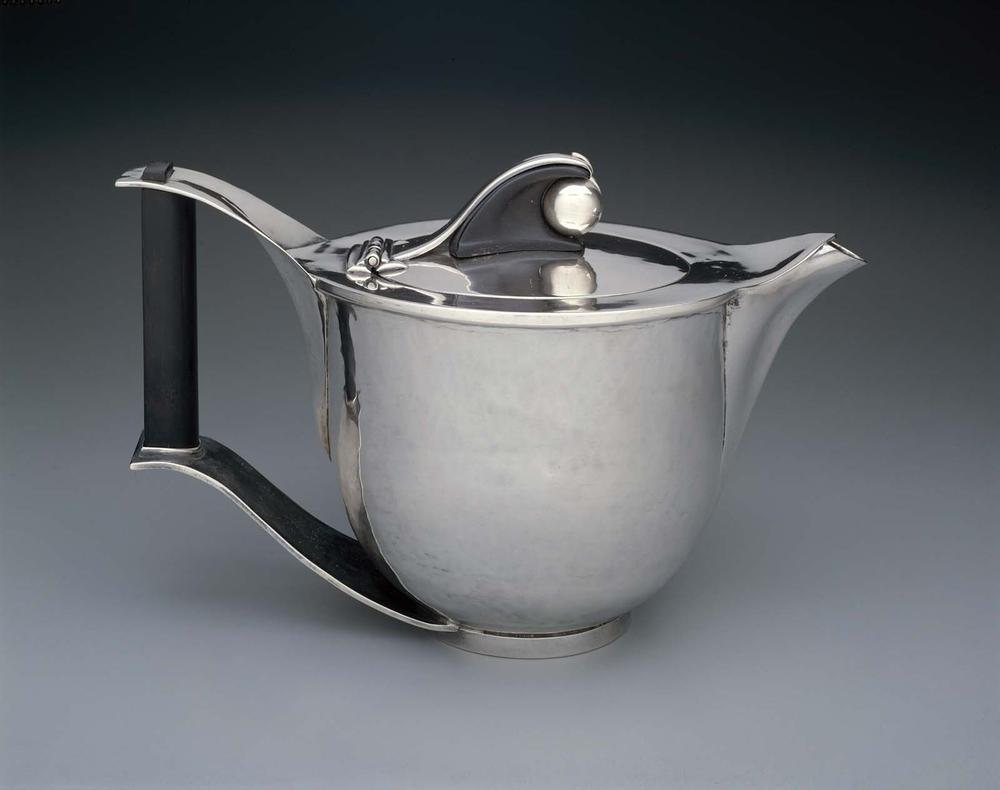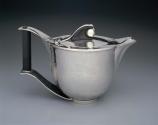Advanced Search
Teapot
Margret Craver (American, 1907–2010)
about 1936
Object Place: Wichita, Kansas, United States; Object Place: Detroit, Michigan, United States
Medium/Technique
Silver, Gabon ebony
Dimensions
14 x 23.5 x 13.9 cm (5 1/2 x 9 1/4 x 5 1/2 in.)
Credit Line
Museum purchase with funds donated in memory of Joyce Goldberg by John Axelrod, Mr. and Mrs. Sidney Stoneman, Mr. Charles Devens, Mr. and Mrs. Peter S. Lynch, The Seminarians, Mr. James G. Hinkle, Jr., The MFA Council and Friends
Accession Number1988.533
NOT ON VIEW
CollectionsAmericas
ClassificationsSilver hollowware
As a teacher, innovator, jeweler, and silversmith, Kansas-born Margret Craver is a twentieth-century artist of the first rank. Her work represents a link between Arts and Crafts silversmiths and artists of the postmodern era. In addition, Craver is one of the few women of her generation to have received international recognition for her achievements in metalsmithing.
Craver first encountered the craft as a young student at the University of Kansas. After graduation, she taught a variety of media, including silversmithing and jewelrymaking, at the Wichita Art Association. During the 1930s, the association was one of the few institutions committed to raising contemporary decorative arts to a national level. During the summers, she worked in the studios of established artists. She studied with Wilson Weir of Tiffany’s; Stone Associates of Gardner, Massachusetts; and Arthur Nevill Kirk (1881 – 1958), a leading metalworker and first professor in the craft at Cranbrook Academy. From Leonard Heinrich, chief armor conservator at the Metropolitan Museum, Craver learned the silversmith’s essential skill — the art of toolmaking. She maintained contact with the university, traveling to Europe with design department director Marjorie Whitney in 1938, the same year in which she studied with Baron Erik Fleming (1894 – 1954), silversmith to the king of Sweden.
During the war, Craver worked with Handy and Harman, a leading refiner of precious metals, to develop therapeutic projects for returning veterans. She then directed Handy and Harman’s newly formed Craft Service Department, which trained design teachers in the making of hollowware. As part of this effort, Handy and Harman sponsored five National Silversmithing Workshop Conferences between 1947 and 1959. Craver enlisted Fleming and Sheffield College of Arts and Crafts professor William Ernest Bennett (1906 – w. 1967) as instructors. The conferences greatly influenced the direction of American silversmithing, as many of the graduates were responsible for the first wave of postwar metalsmithing departments organized throughout the country.
This teapot was the first major work in hollowware undertaken by the artist. It is entirely her own design and was made under Kirk’s direction. Her personal aesthetic is evident in the lively profile, whose light, almost birdlike stance belies the capacious volume within. Fully conceived and executed, the teapot displays none of the hesitancy usually associated with an artist’s early work.
Craver’s lifelong dedication to metalwork and her revival and modern reinterpretation of the lost en résille enameling
technique place her among the first rank of American silversmiths and jewelers. Her work has been seen in the groundbreaking “Objects: USA” exhibition of 1970 and, more recently, “The Eloquent Object” (1987) and “Women Designers in the USA, 1900 – 2000” (2000). Her honors include membership in the Master Gold and Silversmiths Guild of Sweden; fellowship in the American Crafts Council; and the council’s Medal of Excellence. Her small but exceptional oeuvre can be seen at the Renwick Museum, the Metropolitan Museum of Art, and the Art Institute of Chicago.
This text has been adapted from "Silver of the Americas, 1600-2000," edited by Jeannine Falino and Gerald W.R. Ward, published in 2008 by the MFA. Complete references can be found in that publication.
Craver first encountered the craft as a young student at the University of Kansas. After graduation, she taught a variety of media, including silversmithing and jewelrymaking, at the Wichita Art Association. During the 1930s, the association was one of the few institutions committed to raising contemporary decorative arts to a national level. During the summers, she worked in the studios of established artists. She studied with Wilson Weir of Tiffany’s; Stone Associates of Gardner, Massachusetts; and Arthur Nevill Kirk (1881 – 1958), a leading metalworker and first professor in the craft at Cranbrook Academy. From Leonard Heinrich, chief armor conservator at the Metropolitan Museum, Craver learned the silversmith’s essential skill — the art of toolmaking. She maintained contact with the university, traveling to Europe with design department director Marjorie Whitney in 1938, the same year in which she studied with Baron Erik Fleming (1894 – 1954), silversmith to the king of Sweden.
During the war, Craver worked with Handy and Harman, a leading refiner of precious metals, to develop therapeutic projects for returning veterans. She then directed Handy and Harman’s newly formed Craft Service Department, which trained design teachers in the making of hollowware. As part of this effort, Handy and Harman sponsored five National Silversmithing Workshop Conferences between 1947 and 1959. Craver enlisted Fleming and Sheffield College of Arts and Crafts professor William Ernest Bennett (1906 – w. 1967) as instructors. The conferences greatly influenced the direction of American silversmithing, as many of the graduates were responsible for the first wave of postwar metalsmithing departments organized throughout the country.
This teapot was the first major work in hollowware undertaken by the artist. It is entirely her own design and was made under Kirk’s direction. Her personal aesthetic is evident in the lively profile, whose light, almost birdlike stance belies the capacious volume within. Fully conceived and executed, the teapot displays none of the hesitancy usually associated with an artist’s early work.
Craver’s lifelong dedication to metalwork and her revival and modern reinterpretation of the lost en résille enameling
technique place her among the first rank of American silversmiths and jewelers. Her work has been seen in the groundbreaking “Objects: USA” exhibition of 1970 and, more recently, “The Eloquent Object” (1987) and “Women Designers in the USA, 1900 – 2000” (2000). Her honors include membership in the Master Gold and Silversmiths Guild of Sweden; fellowship in the American Crafts Council; and the council’s Medal of Excellence. Her small but exceptional oeuvre can be seen at the Renwick Museum, the Metropolitan Museum of Art, and the Art Institute of Chicago.
This text has been adapted from "Silver of the Americas, 1600-2000," edited by Jeannine Falino and Gerald W.R. Ward, published in 2008 by the MFA. Complete references can be found in that publication.
DescriptionThe raised vessel has an applied narrow ring foot that is roughly circular in section, with strainer holes cut in the body and a V-shaped spout affixed to the body. The shoulder soldered to the body is flat, lozenge-shaped, and upturned at each end, creating a transition to the spout and handle; a three-part hinge secures the lid, which has a finial made of Gabon ebony and a hollow silver sphere. The handle is formed with two sheets of silver that spring from above the foot and the shoulder. A shaped, Gabon ebony grip connects these elements and completes the whole.
Marks
"C" within a stylized six-petaled flower
InscriptionsNone.
ProvenanceMade by the artist and retained in her personal collection until acquired by the museum in 1988.
CopyrightReproduced with permission.





